Posts Tagged Revit
When I say BIM what do you think? The US Army Corp of Engineers thinks Revit
Posted by Jim Foster in Adoption, Autodesk, BIM, Revit on December 2, 2010
While I am no shill, I just pasted this straight from the wire. Info you can use? Maybe/Maybe not, but if your trying get on schedule with the US Government for projects, I’d say knowing Revit is better than not knowing it, and here’s another data point why.
USACE Selects Autodesk Software Solutions for Mission Critical Applications
LAS VEGAS, Nov 29, 2010 (BUSINESS WIRE) — Autodesk University:
Autodesk, Inc. /quotes/comstock/15*!adsk/quotes/nls/adsk (ADSK 36.53, +1.24, +3.51%) , a world leader in 3D design, engineering and entertainment software, today announced that the U.S. Army Corps of Engineers (USACE), has signed a multi-flex, enterprise license agreement for Autodesk products and Autodesk-related services and training. The contract value of the deal is $6 million over a three year period and includes access to the following Autodesk products: the Autodesk Revit family of products; AutoCAD Civil 3D software; and Autodesk Navisworks software products, among others.
“We are extremely pleased to further strengthen our long-standing relationship with the USACE with this agreement,” said Bill Goodson, vice president, North American public sector and utility sales, at Autodesk. “Autodesk software plays a vital role in helping USACE provide quality and responsive engineering services to over 37,000 employees in 90 countries worldwide. This agreement ensures USACE will have full access to the latest innovative Building Information Modeling (BIM) software tools and professional services to support its national defense mission. The flexible and concurrent licensing Autodesk is offering the USACE will provide better asset management and version control.”
Autodesk Software Products: Mission Critical Solutions for USACE
As BIM-based designs are required by the General Services Administration (GSA), the USACE now requires a BIM-based design approach for all vertical military construction (MILCON) projects in fiscal year 2010 and beyond. With today’s announcement, the USACE will now have complete access to Autodesk’s BIM family of products, including Autodesk Revit Architecture software and Navisworks software products. By having access to the BIM products, USACE personnel — who deal with managing building construction, operations and maintenance — will have the software tools and training necessary to take better advantage of the 3D building models being delivered by design contractors.
Reality Capture #2 on Autodesk Labs Hit List : Project Galileo to join other tools. BIM
Posted by Jim Foster in 3D, Autodesk, BIM, Built Environment, Point to Point Laser Technology, Revit on November 30, 2010
 As reported by Matt Ball, Brian Mathews, the Autodesk VP in charge of Autodesk Labs, gave a media briefing updating ‘his Seven Technology Trends lecture with example projects.’ Reality capture or as otherwise stated, turning analog into digital, being #2 on the hit list. So capturing the Built Environment is starting to get serious traction, and while I hesitate to use the word traction, well, that’s what its getting.
As reported by Matt Ball, Brian Mathews, the Autodesk VP in charge of Autodesk Labs, gave a media briefing updating ‘his Seven Technology Trends lecture with example projects.’ Reality capture or as otherwise stated, turning analog into digital, being #2 on the hit list. So capturing the Built Environment is starting to get serious traction, and while I hesitate to use the word traction, well, that’s what its getting.
Previously in the conversation people would talk about all the wonderful things software can do for buildings, then you realize the majority of construction is in the built environment and it becomes, well just give me the building, or at lest the digital equivalent of the building and look at the wonderful things software can do, however, most presupposed the digital equivalent of the building. Not anymore, more and more companies are releasing software and tools to capture the built environment, or call it reality capture if you like, but soon there are going to be a lot more tools on your shelf.
Autodesk has released, Project Photofly . and will soon release Project Galileo which according to its splash page, “is an easy-to-use planning tool for creating 3D city models from civil, geospatial and building data, and 3D models.” Plus Autodesk has release shape extraction tools from PointClouds directly inside of AutoCAD. Rand Technology/Avatech/Imaginit hybrid has released PointCloud manipulation tools inside of Revit and we are in the final beta of PKNail, a PPLT (Point to Point Laser Technology) system that allows a user to drive Revit commands and enter dimensional data directly from a range finder allowing a user to build a Revit model in the field. Plus we recently saw the beautiful kinect hack allowing a user to capture and even measure 3D video. I can’t say which technology or mixture of technologies will work best for you, but your job is going to get easier.
Sketch Up vs Revit : Round 2 : Autodesk and Revit scores with Vasari
Posted by Jim Foster in 3D, Autodesk, BIM, New Technologies on November 15, 2010
Is it fair to continually compare Revit and SketchUp as essentially they were doing two different things, Conceptual Modeling as compared to Building Modeling, not anymore with the release of Project Vasari, alive and available for download. It is available as a preview and free until May 15, 2011. I will be downloading it shortly, and from the looks of it and as posted by other bloggers, like the Revit Kid and David Light here are some of the features:
- Stripped Down Revit User Interface
- Built in Energy Modeling
- Produce conceptual models using both geometric and parametric modeling functionality
- Cross Compatibility between Revit 2011 and Vasari files.
In fact, I even suggest to jump over to David’s post to get a more in depth look at Vasari and its features. However, what has been apparent to me and others was for Autodesk to round out their line up with a conceptual modeling tool, and with something that had the ease of SketchUp. Why? Because I would speak to architects who had never even fired up any CAD package who said they are now using SketchUp, plus with idea of a Revit Light you can create an easy entry point for users rather than be bamboozled by full Revit UI/Ribbon/Feature smorgasbord. In addition to the easy entry point models created in Vasari can be opened in Revit 2011 and visa-versa so going from concept to modeling in Revit Architecture should be easier, conceivably, although I have not seen that work flow.
I imagine pricing, when the free release ends, has to be somewhere within the SketchPro version which is at $495. But not sure how that would work through the VAR channel, maybe it’ll be free as an entry point or lead generation tool. SketchUp also allows you to trace photos to try and recreate real world elements, plus validation and analysis. There’s a battle going on for building design and life cycle management; makes you wonder what Google produces or buys next – a BIM authoring tool, or possibly model integration a’la Horizontal Glue. The global AEC industry is $4.6 Trillion, and if you think of buildings as customers, energy customers, retail customers, services customers, why wouldn’t you want to be a part of that. Score one for Autodesk.
Laser to Revit : Laser to BIM : New Tools to Capture the Built Environment
Posted by Jim Foster in BIM, Built Environment, disto, Laser BIM, Revit on November 13, 2010
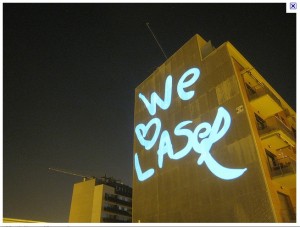 With PointKnown’s introduction of PKNail and PPLT (Point to Point Laser Technology) utilizing a Leica Disto and Rand Technologies recent press release announcing the ability to manipulate and manage laser scan, point cloud data within Revit the opportunity and tools to capture existing conditions continues to grow. Combine that with the growing need to capture existing conditions for energy modeling and retrofits and you can see an industry emerging, not just using it for special circumstances but start capturing existing structures in 3D/BIM for uses that range from space planning, facility management, energy audits and beyond.
With PointKnown’s introduction of PKNail and PPLT (Point to Point Laser Technology) utilizing a Leica Disto and Rand Technologies recent press release announcing the ability to manipulate and manage laser scan, point cloud data within Revit the opportunity and tools to capture existing conditions continues to grow. Combine that with the growing need to capture existing conditions for energy modeling and retrofits and you can see an industry emerging, not just using it for special circumstances but start capturing existing structures in 3D/BIM for uses that range from space planning, facility management, energy audits and beyond.
While it has been reported and analyzed that some of the biggest frustrations, time sinks and expenditures is that lack of interoperability between software, and redundant efforts between disciplines, that is creating the same thing, many times for each discipline the advent of BIM authoring tools like Revit, and ways to combine and work with them can help firms and individuals reduce rework and create more opportunities for their design and construction work; looks like a win all around. And with these technologies firms can start on existing structures in BIM and Revit and have all the benefits.
PointKnown Nails It. Rapid Models Autodesk AEC HQ in Waltham: Pilot moves on.
Posted by Jim Foster in 3D, BIM, New Technologies on November 4, 2010
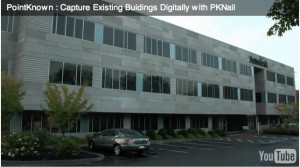 So some individuals at Autodesk got to see our ‘handcrafted’ videos available at our PKLabs YouTube Channel and got in touch. Ani Deodhar, a Program Manager in their Sustainability Group, explained to me he had a mandate to come up with the best work flows across all of their product lines in order to energy model existing buildings. They have been working on geometry extraction in the labs and anyone who has seen the Photofly demos can attest, this looks very promising. However, our goal with PKNail was always to capture dimensionally correct space and do so with a minimum of software knowledge so PKNail can be leveraged across an organization rather than with a specialized few. I am not knocking any process just pointing out that if you want to move a pallet, for example, it would be nice you could just do it rather than find the guy or gal with the forklift license and then ask them to move it, and then hopefully you get it right the first time. Maybe not the best metaphor but you get it, the more people that can do something, the more of whatever ‘it’ is you can do.
So some individuals at Autodesk got to see our ‘handcrafted’ videos available at our PKLabs YouTube Channel and got in touch. Ani Deodhar, a Program Manager in their Sustainability Group, explained to me he had a mandate to come up with the best work flows across all of their product lines in order to energy model existing buildings. They have been working on geometry extraction in the labs and anyone who has seen the Photofly demos can attest, this looks very promising. However, our goal with PKNail was always to capture dimensionally correct space and do so with a minimum of software knowledge so PKNail can be leveraged across an organization rather than with a specialized few. I am not knocking any process just pointing out that if you want to move a pallet, for example, it would be nice you could just do it rather than find the guy or gal with the forklift license and then ask them to move it, and then hopefully you get it right the first time. Maybe not the best metaphor but you get it, the more people that can do something, the more of whatever ‘it’ is you can do.
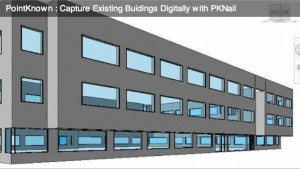 On site at Autodesk Waltham and using PKNail we were able to survey, measure, build in real time the shell of the building in Revit in less than 3 hours. Then depending on what level of detail, and features you want in the deliverable you may want to spend sometime in the office. However, when we left we knew we had all the key dimensions and information and the model itself was built. This was done at a level needed for energy modeling and we only modeled from the exterior but PKNail allows you to create interior layouts, floor by floor as needed as well. It was then ported through Revit CEA to create an energy analysis of the building.
On site at Autodesk Waltham and using PKNail we were able to survey, measure, build in real time the shell of the building in Revit in less than 3 hours. Then depending on what level of detail, and features you want in the deliverable you may want to spend sometime in the office. However, when we left we knew we had all the key dimensions and information and the model itself was built. This was done at a level needed for energy modeling and we only modeled from the exterior but PKNail allows you to create interior layouts, floor by floor as needed as well. It was then ported through Revit CEA to create an energy analysis of the building.
When creating PKNail we wanted to make things easier on ourselves. The product grew organically from our architectural surveying business. When you’ve repeated the same task enough times, or if you missed a crucial step or measurement that would require you to back to the field, etc. you think there must be a better way. Just like when you make the jump from 2D to 3D you thought, there must be a better way to communicate with my clients, coordinate views, coordinate disciplines, and here it is. Revit is increasingly becoming that better way. Use it however you want, it’s a tool, you can use it communicate visually with your clients if that’s what you need it for or use it to coordinate construction; your choice but it helps. PKNail allows you to quickly and accurately capture existing buildings digitally, either just the exterior for energy modeling or to start your as-built documentation.
On a recent conference call to discuss our pilot with Autodesk, one of the attendees said something like this:
“So you simplified the GUI to automate the tasks you need when surveying and allowed for the wireless capture of data to minimize key stroking”
Well, I don’t know if I would say it exactly like that, but yeah, that’s what we did, and I added that we created a workflow and process that squeezes the surveying knowledge of our organization into the software so people can be a success right out of the box. We wanted to take something simple, point and shoot distance meters, very simple and marry it with something that can be infinitely complex, 3D BIM authoring tools as in Revit, and in turn try to make that simple. Measure a wall/build a wall, window, levels, etc. We call this PPLT (Point to Point Laser Technology). So until we got robots doing this stuff we can never take away the human element from what we do, and so, let’s make just make it easier, faster, better, much like the $6 million dollar man.
Survey Angled Walls in Revit with a Disto and PKNail
Posted by Jim Foster in Point to Point Laser Technology, Revit on August 4, 2010
One of the tougher issues and part of any surveyors work flow is to capture non-orthogonal (i.e. angled) geometry correctly the first time. This increases in importance if the angles are played throughout the building and especially if they are part of the exterior. In order to help users capture a building’s geometry in Revit while in the field PointKnown has incorporated triangulation and a close room function as part of our PKNail Building Surveying Software. Having the Disto drive Revit allows quicker data capture and increased accuracy. And while many of us might want to be watching videos of the beach in August I still included the process here as well.
BIM CAD Throwdown : Dassault Takes Aim with Catia Live Building and Draftsight
Posted by Jim Foster in 3D, BIM, cloud, New Technologies, Open Standard, SaaS on July 30, 2010
Holy frontal assault Batman. Dassault, the french producer of CATIA (Computer Aided Three-dimensional Interactive Application) / Solidworks is making a strong move into the world of architecture. CATIA, generally used in the aerospace and engineering fields, has also been used successfully by Gehry to produce his curvilinear buildings. They are now introducing 2 products aimed squarely at the Autodesk Bullseye, a CAD application developed through the IntelliCAD Consortium (ITC) and the Open Drawing Alliance (ODA) called Draftsight and its going to be free, yup free. And is available here.
And while it is available for the Windows Family of OS (XP / Vista / Seven) MAC and Linux versions are in the pipeline, take that into account that IBM, you’ve heard of them, markets these solutions worldwide and that complaints about Revit not handling larger products are scattered across user groups and BIM forums one can believe there is an opening. Additionally, if they are following the SaaS path of putting Draftsight in the cloud for file sharing/integrity it becomes a pretty powerful argument to think about switching, especially if all the ingrained keystroke commands and shortcuts from AutoCAD are copied along with it. Having seen the Intellicad interface, I think that most likely a yes.
Excellent article at AEC Magazine that covers the introduction in depth, and thanks to @amonle / John Allsopp twitter for bringing this to my attention. I’ve included a portion below.
Based on a future version of Catia and its data management system Enovia, Dassault Systèmes is developing a competitive parametric modelling solution to compete with Autodesk’s Revit BIM (Building Information Modelling) tool. I understand that the next update of Catia will store its data in the cloud and Catia will potentially be downloaded and licensed from the desktop. This will enable Dassault Systèmes to overcome the fact that it does not have a value-added reseller channel to sell Catia Live Building but needs to compete with an established and low-cost player.
The brief demonstration showed an architectural model being rapidly developed and edited using Catia. Bernard Charlès said that the new product could do modelling in seconds, what Revit would take 45 minutes to do. And Dassault Systèmes should know — it was among the many original investors in the start-up company that developed the first version of Revit.
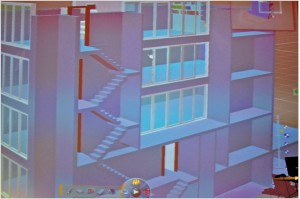 While Revit has captured the mindshare here in the US and Down Under among other places no one can discount the Dassault / IBM alliance and their entrance into the AEC industry in a big way. The amount of consulting opportunities and hardware sales should have IBM salivating. So if Draftsight is free, what is Live Building coming in at?
While Revit has captured the mindshare here in the US and Down Under among other places no one can discount the Dassault / IBM alliance and their entrance into the AEC industry in a big way. The amount of consulting opportunities and hardware sales should have IBM salivating. So if Draftsight is free, what is Live Building coming in at?
Design Build Boom : AECOM acquires Tishman : #BIM
Posted by Jim Foster in BIM, economic trends, Virtual Construction on July 16, 2010
 I have suggested among others that the optimum work flow could be architects focus on the design, not construction docs or the BIM, but the design and then consult during the actual engineering and BIM process, that way it minimizes redundant efforts especially in regards to BIM creation. This process also would suggest the rise of design/build firms. AECOM just took a huge bite out of that apple when terms were disclosed yesterday that they agreed to acquire Tishman for $245 Million Dollars creating a design/build behemoth. Strategically, vertical integration is a double edged sword. Positively, you have control of costs and quality and capture every last dime a developer was intending to put into the project. Negatively, you have to feed the beast and can you really be that good at all disciplines?
I have suggested among others that the optimum work flow could be architects focus on the design, not construction docs or the BIM, but the design and then consult during the actual engineering and BIM process, that way it minimizes redundant efforts especially in regards to BIM creation. This process also would suggest the rise of design/build firms. AECOM just took a huge bite out of that apple when terms were disclosed yesterday that they agreed to acquire Tishman for $245 Million Dollars creating a design/build behemoth. Strategically, vertical integration is a double edged sword. Positively, you have control of costs and quality and capture every last dime a developer was intending to put into the project. Negatively, you have to feed the beast and can you really be that good at all disciplines?
On a side note, I was speaking to an integration specialist at Bentley who told me AECOM was a Microstation shop. This may be because back in the day the US Government was using a lot of Microstation and AECOM gets the majority of their work from the public sector. Tishman, and I am only speculating here, was most likely Revit. Skidmore, Owings & Merrill LLP (SOM) used Revit at World Trade and Tishman was on as construction. Quick google search shows they still seem to use it on current projects. Future projects and technology they use could be a proxy for the industry.
Revit As Built : Field BIM Technology : Build Digitally As You Measure : #BIM #Revit
Posted by Jim Foster in BIM, Laser BIM, New Technologies, Point to Point Laser Technology, Revit on July 2, 2010
It’s been a hau l and it starts with a quote from Irwin Jungreis one of the founders of Revit who I spoke to early in the process, ‘we never intended Revit to have an API,’ he said with a smile. ” It was supposed to be so good it would never need 3rd Party applications.” “WHAT?!” you say. I believe Irwin at the point understood the original hubris of that statement but then again I spoke to him after they sold out to Autodesk. “So what” we thought and we continued to forge ahead with an API that had as much horsepower as my old Puch moped. Thank you Autodesk for your continued efforts in beefing up the API but it has been a bear.
l and it starts with a quote from Irwin Jungreis one of the founders of Revit who I spoke to early in the process, ‘we never intended Revit to have an API,’ he said with a smile. ” It was supposed to be so good it would never need 3rd Party applications.” “WHAT?!” you say. I believe Irwin at the point understood the original hubris of that statement but then again I spoke to him after they sold out to Autodesk. “So what” we thought and we continued to forge ahead with an API that had as much horsepower as my old Puch moped. Thank you Autodesk for your continued efforts in beefing up the API but it has been a bear.
PointKnown is getting closer to releasing the commercial version of PKNail; it’s building surveying software. PKNail was programmed behind 7 years of building surveying experience. Our intention was to:
- Automate many of the rote tasks when creating existing conditions surveys of a building
- Create repeatable work flows
- Increase speed and accuracy by linking measurements directly into Revit
We understand surveying can be the bane of some people’s existence and it is a necessary evil to almost all projects, that is having accurate information to start the project. While we never considered it a bane or evil but when we would put on lunch and learns and dog and pony shows we usually got one of two reactions. One, where have you been my whole life I hate surveying or two, will you sell us the software because we do all our own measuring. We get it. And building in real time, in the field makes thing easier and building inside a familiar platform, and one that you will be designing or working in anyway makes you more productive right out of the box. I look forward to your feedback, comments we’re here to work with you. And to summarize my last statement in the video, ‘We’re much better at designing surveying software than making videos,’ but even comments on our production and lack of directing talents are welcome. Thanks for reading. – jim
Revit As Built : Field BIM : Existing Conditions
Posted by Jim Foster in BIM, New Technologies, Revit, Uncategorized on June 29, 2010
While I don’t usually take the time to pump my own gas with this blog I wanted to share the complete reversal in our deliverables over the last year. It used to be, way back at the end of 2008 that we delivered most of our building surveys in 2D AutoCAD format, now we would build in 3D, normally in ADT but our clients wanted 2D AutoCAD. From a surveying perspective a 3D object oriented universe worked better for us because essentially all the views were coordinated, that is build it in the floorplan directly, it is represented in elevation correctly. Anyone who has keyed up a plan in 2D knows where I am coming from, which if you are here reading this, means you know what I am talking about. Now, however, the bulk of what we do is deliver as-builts in Revit. The GSA requiring BIM has a lot to do with it, I believe, and Autodesk being the biggest player in the US means Revit becomes the default. Whether you like that or not does not matter, that’s the reality.
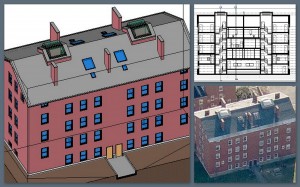 Recently we have performed as built surveys at Phillips Exeter and Emmanuel College and we were field testing our laser to BIM technology, PKNail. It was created to capture typical conditions quickly and accurately. If you wanted to capture the Capitol Dome, I would suggest laser scanning, for capturing most situations Point to Point Laser Scanning (PPLT) should work just fine. PKNail converts measurements directly into a Revit workstation-wirelessly, measure a wall that wall is entered into Revit, encounter a door, window, Fire Extinguisher Cabinet, sink, if you can measure it, it can be placed quickly and easily into the model.
Recently we have performed as built surveys at Phillips Exeter and Emmanuel College and we were field testing our laser to BIM technology, PKNail. It was created to capture typical conditions quickly and accurately. If you wanted to capture the Capitol Dome, I would suggest laser scanning, for capturing most situations Point to Point Laser Scanning (PPLT) should work just fine. PKNail converts measurements directly into a Revit workstation-wirelessly, measure a wall that wall is entered into Revit, encounter a door, window, Fire Extinguisher Cabinet, sink, if you can measure it, it can be placed quickly and easily into the model.
Lastly, if the deliverable is 2D CAD, exporting views from Revit to AutoCAD sheets is a snap. Here’s a long winded Autodesk treatise on the subject or well, it looks like I will need to update with a screen capture video the quick process but the resulting CAD contains some of the meta information collected in 3D, such as 30″ Door, rather than creating anonymous objects. Next post will follow in short order with a sneak peak of some of the features and the connectivity between Revit and a Leica Disto enabled by PointKnown surveying software.
Thanks for tolerating some self promotion.

